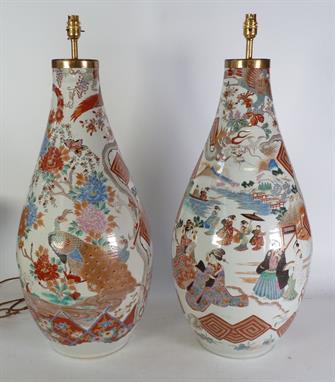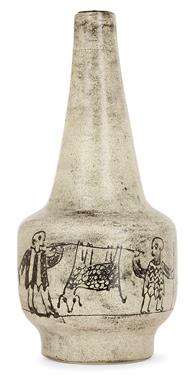We found 307207 price guide item(s) matching your search
There are 307207 lots that match your search criteria. Subscribe now to get instant access to the full price guide service.
Click here to subscribe- List
- Grid
-
307207 item(s)/page
IMPRESSIVE PAIR OF JAPANESE LATE MEIJI PIERCED ARITA PORCELAIN VASES, now adapted as electric lamp bases of footed pear shaped form, painted in colours and gilt with three toed dragons, exotic birds, tapestry panels and figures at leisure, 26 1/2"" (67.3cm) high, tops mounted with brass fittings and holes drilled to sides (2)
A Victorian Oil Lamp with frosted blue highlighted shade to a clear glass font, brass pedestal and raised on a slag base, 19" high Condition:Shade appears to be late 19th/early 20th Century it is generally good condition only very minor nibbles to base. Lamp has no wick or fuel to test if working. Metal work appears corroded.Please note: Keys Fine Art Auctioneers take great care to ensure that any statements as to attribution, age, date, origin, provenance and condition are reliable and accurate but it should be noted that all such statements are skilled opinions, if provenance (written or historical fact) cannot be produced. However, Keys Fine Art Auctioneers do not guarantee that condition reports, whether included in the catalogue, or given at a later time; cover all aspects of an item(s) condition. All clocks, watches and mechanical items are sold on behalf of vendors by Keys Fine Art Auctioneers strictly on an “As Found” basis.No guarantee or warranty is issued or given in anyway, either written or verbal and therefore refunds will not be issued on the basis of the Lot not being “in working order”, “incomplete”, or “not in original condition”.Keys Fine Art Auctioneers would respectfully ask that prospective buyers view Lots in person, wherever issues regarding condition are seen as important to them, satisfying themselves as to the condition, completeness and originality of any Lot on which they intend to bid.
Late 19th century or early 20th century French spelter lamp modelled as a winged male figure, on granite base, title Le Genie Human, further inscription panel below, signed E Picault? with glass shade, 74cm high CONDITION REPORT Generally in good condition, corner front left chipped underside
Peter Heap of Wetwang: A "Rabbitman" oak standard lamp, the tapering faceted stem continuing to an X-form base, adzed, with carved rabbit signature. 141cm to top of fitting Note: Peter Heap trained with Thompsons of Kilburn in the 1950's/60's before leaving to set-up his own workshop in circa 1970.
Peter Heap of Wetwang: A "Rabbitman" oak standard lamp, the tapering faceted stem continuing to an X-form base, adzed, with carved rabbit signature. 141cm to top of fitting Note: Peter Heap trained with Thompsons of Kilburn in the 1950's/60's before leaving to set-up his own workshop in circa 1970.
Arthur Armstrong RHA (1924-1996) STILL LIFE WITH LAMP oil on board signed lower right; titled and numbered [28] on reverse 24 by 30in. (60.96 by 76.20cm) Arthur Armstrong (19241996) was a painter from County Antrim, who often worked in a Cubist style and produced landscape and still life works. Armstrong was born in Carrickfergus on 12 January 1924. He was the son of a house painter and attended Strandtown Primary School. Later he studied architecture at Queen`s University Belfast, but after two years he moved to study art at Belfast College of Art. The influence of Cubism and the School of Paris can be clearly seen in his work, which took him to England, France and Spain. He also travelled and painted in the West of Ireland with fellow artists and close friends Gerard Dillon and George Campbell. Connemara inspired some of his best work. In 1950 his work was exhibited in the Grafton Gallery in Dublin, and subsequent exhibitions took place in England, Spain and the United States, as well as in Belfast and Dublin. In 1957 he was awarded a travelling scholarship from the Council for the Encouragement of Music and the Arts (a forerunner of the Arts Council of Great Britain) and went to Spain. He eventually settled in Dublin in 1962 and began showing work at the Royal Hibernian Academy.In 1968 he was awarded the Douglas Hyde Gold Medal at the Oireachtas Exhibition. In 1969 he designed sets (with George Campbell and Gerard Dillon) for the Seán O`Casey play, Juno and the Paycock, at the Abbey Theatre in Dublin. He became a member of the Royal Hibernian Academy in 1972 and in 1973 he was awarded the Art in Context prize from the Arts Council of Northern Ireland. He became a member of Aosdána in 1981, the same year that a retrospective exhibition of his work from 1950 to 1980 was held by the Arts Council of Northern Ireland.
SERGE MOUILLE (1922-1988)A black lacquered wall lamp with two metal arms. (Slight distorsions on the lampshade). Height. max. 38 3/8 in.- Length. (arm) 50 in.- Length. (inferior arm) 33 1/8 in. Bibliographie?: Pierre-Emile Pralus, ""Serge Mouille, un classique français"", Les Éditions du Mont Thou, Saint-Cyr au Mont dOr, 2006, pp. 66,166,167,170,171.
Serge MOUILLE (1922-1988)A standard lamp with three-leg base. White lacquered metal. (Repainted, small executions on the lampshade). Height. 62 in.- Width. 18 1/2 in. Depth. 29 1/2 in Bibliographie?: Pierre-Emile Pralus, ""Serge Mouille, un classique français"", Les Éditions du Mont Thou, Saint-Cyr au Mont dOr, 2006, pp. 66,69,115,130,156,157.
Serge MOUILLE (1922-1988)A standard lamp with three-leg base. White lacquered metal. (Repainted, small executions on the lampshade). Height. 62 in.- Width. 18 1/2 in. Depth. 29 1/2 in Bibliographie?: Pierre-Emile Pralus, ""Serge Mouille, un classique français"", Les Éditions du Mont Thou, Saint-Cyr au Mont dOr, 2006, pp. 66,69,115,130,156,157.
-
307207 item(s)/page






































![Arthur Armstrong RHA (1924-1996) STILL LIFE WITH LAMP oil on board signed lower right; titled and numbered [28] on reverse 2](http://lot-images.atgmedia.com/SR/10092/2915938/54-20141110171433_468x382.jpg)










